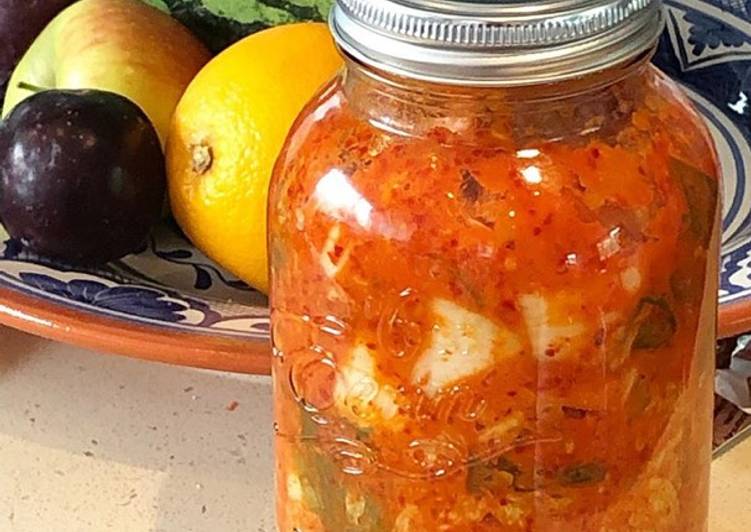Kimchi...Easy and Fast Recipe. Baechu-kimchi, or cabbage kimchi, is the most common type of kimchi. Originally developed as a way to preserve fresh vegetables well into winter, kimchi is an example of basic fermenting at work: depriving the vegetables of air prevents spoilage and allows the naturally occurring bacteria to transform the available starches and sugars into an acid that's particularly well-suited for preserving. Your recipe was both fast and easy and produce wonderful kimchi.
 In a small bowl, whisk salt, sugar, gochugaru, and water. Pour over the cabbage and other vegetables in the bowl. Place a plate on top of the cabbage and place a stack of heavy bowls on top of that. You can have Kimchi...Easy and Fast Recipe using 10 ingredients and 6 steps. Here is how you achieve it.
In a small bowl, whisk salt, sugar, gochugaru, and water. Pour over the cabbage and other vegetables in the bowl. Place a plate on top of the cabbage and place a stack of heavy bowls on top of that. You can have Kimchi...Easy and Fast Recipe using 10 ingredients and 6 steps. Here is how you achieve it.
Ingredients of Kimchi...Easy and Fast Recipe
- It's 1 of large Chinese Cabbage (Napa Cabbage) or two small ones.
- It's 2 bunches of spring onions washed and trimmed.
- It's 2-3 of large carrots thinly sliced or peeled into long strips with a potato peeler.
- It's 1/2 cup of salt.
- Prepare 1/2 cup of Korean chilli powder.
- You need 12-15 cloves of garlic peeled.
- Prepare 4 inches of ginger peeled and rough chopped.
- It's 1 tablespoon of fish sauce (omit for vegan version).
- You need of Unsweetened pear or apple juice.
- You need 4 tablespoons of white miso paste.
The main ingredients of kimchi are napa cabbage, scallions (green onions), chili peppers and garlic. The process of making kimchi is thorough and time consuming. Napa leaves are soaked in a salt water mixture for a couple of hours. T his radish version of Korean Kimchi packs tons of flavors and is loaded with fiber and vitamins.
Kimchi...Easy and Fast Recipe step by step
- Cut the cabbage into halves, remove the hard core at the bottom, halve again and then cut it into 2 inch pieces. Put into a big bowl with the carrots, sprinkle with the salt and massage the veg until everything is well coated with the salt and it starts looking like it’s wilting. Cover it all with water and leave it to soak for 1.5-2 hours. The cabbage ribs should be quite bendy if you test them after this time..
- Cut off the white parts of the spring onions and put them into a food processor with the garlic, ginger, miso and the Korean pepper powder. Turn it on high until fairly smooth. Add the fish sauce (if using) and a good few glugs of the fruit juice and blitz it again until it looks something like runny cake batter..
- Pour the veg into a strainer and let the salty water run through. Put it into a big stain resistant bowl. Roughly slice the green parts of the spring onions, add to the cabbage and carrot mix. Pour the chilli paste over everything. Use gloves to massage the paste into everything. I use my “special” kimchi wooden spoon and just stir the lot really well until everything is covered in paste..
- Time to pack it into jars. This recipe makes about 2 litres of kimchi. Use wide neck jars with two-piece screw lids (Mason jar type). No need to sterilise these, just make sure they are very clean and dry. Shove your veg mix in tightly, but leave an inch at the top to avoid a kimchi volcano. Don’t screw the lids on, lightly set the disks in place and hold down with the ring. Place on a rimmed tray and leave at room temperature for up to 72 hours..
- Once a day insert a chopstick into the kimchi to release the air bubbles and push the veg down tightly again with the back of a spoon, trying to keep the veg submerged underneath any liquid accumulated at the top..
- After 72 hours your mak kimchi is ready! Keep it in the fridge where it will happily live up to 6 months...but I doubt it will last that long! Enjoy.😊.
Kimchi is a traditional Korean dish with many benefits that uses the process of fermentation to pickle a spicy, crunchy, usually cabbage-based vegetable mixture. Here, this recipe boasts bold flavors thanks to garlic, ginger and spicy seasoning. Hi Dennis, great to see you want to make kimchi again 😊 This is a traditional kimchi recipe that doesn't require sugar. There are many kimchi recipes out there and you will notice that some of them list sugar as required ingredient whereas others list it as optional. It all comes down to the taste.
Comments
Post a Comment